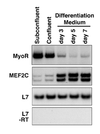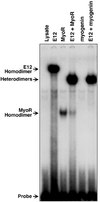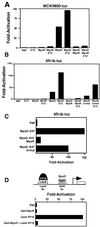MyoR: a muscle-restricted basic helix-loop-helix transcription factor that antagonizes the actions of MyoD
- PMID: 9892671
- PMCID: PMC15174
- DOI: 10.1073/pnas.96.2.552
MyoR: a muscle-restricted basic helix-loop-helix transcription factor that antagonizes the actions of MyoD
Abstract
Skeletal muscle development is controlled by a family of muscle-specific basic helix-loop-helix (bHLH) transcription factors that activate muscle genes by binding E-boxes (CANNTG) as heterodimers with ubiquitous bHLH proteins, called E proteins. Myogenic bHLH factors are expressed in proliferating undifferentiated myoblasts, but they do not initiate myogenesis until myoblasts exit the cell cycle. We describe a bHLH protein, MyoR (for myogenic repressor), that is expressed in undifferentiated myoblasts in culture and is down-regulated during differentiation. MyoR is also expressed specifically in the skeletal muscle lineage between days 10.5 and 16.5 of mouse embryogenesis and down-regulated thereafter during the period of secondary myogenesis. MyoR forms heterodimers with E proteins that bind the same DNA sequence as myogenic bHLH/E protein heterodimers, but MyoR acts as a potent transcriptional repressor that blocks myogenesis and activation of E-box-dependent muscle genes. These results suggest a role for MyoR as a lineage-restricted transcriptional repressor of the muscle differentiation program.
Figures





Similar articles
-
The basic helix-loop-helix transcription factor Mist1 functions as a transcriptional repressor of myoD.EMBO J. 1998 Mar 2;17(5):1412-22. doi: 10.1093/emboj/17.5.1412. EMBO J. 1998. PMID: 9482738 Free PMC article.
-
Muscle LIM protein promotes myogenesis by enhancing the activity of MyoD.Mol Cell Biol. 1997 Aug;17(8):4750-60. doi: 10.1128/MCB.17.8.4750. Mol Cell Biol. 1997. PMID: 9234731 Free PMC article.
-
Failure of Myf5 to support myogenic differentiation without myogenin, MyoD, and MRF4.Dev Biol. 2000 Mar 15;219(2):287-98. doi: 10.1006/dbio.2000.9621. Dev Biol. 2000. PMID: 10694423
-
Combinatorial control of muscle development by basic helix-loop-helix and MADS-box transcription factors.Proc Natl Acad Sci U S A. 1996 Sep 3;93(18):9366-73. doi: 10.1073/pnas.93.18.9366. Proc Natl Acad Sci U S A. 1996. PMID: 8790335 Free PMC article. Review.
-
Vertebrate hairy and Enhancer of split related proteins: transcriptional repressors regulating cellular differentiation and embryonic patterning.Oncogene. 2001 Dec 20;20(58):8342-57. doi: 10.1038/sj.onc.1205094. Oncogene. 2001. PMID: 11840327 Review.
Cited by
-
The basic helix-loop-helix transcription factor capsulin controls spleen organogenesis.Proc Natl Acad Sci U S A. 2000 Aug 15;97(17):9525-30. doi: 10.1073/pnas.97.17.9525. Proc Natl Acad Sci U S A. 2000. PMID: 10944221 Free PMC article.
-
The methyl-CpG-binding protein CIBZ suppresses myogenic differentiation by directly inhibiting myogenin expression.Cell Res. 2011 Nov;21(11):1578-90. doi: 10.1038/cr.2011.90. Epub 2011 May 31. Cell Res. 2011. PMID: 21625269 Free PMC article.
-
Multiple Cell Lineages Give Rise to a Cell Type.Results Probl Cell Differ. 2024;72:83-104. doi: 10.1007/978-3-031-39027-2_5. Results Probl Cell Differ. 2024. PMID: 38509253
-
The transcription factor musculin promotes the unidirectional development of peripheral Treg cells by suppressing the TH2 transcriptional program.Nat Immunol. 2017 Mar;18(3):344-353. doi: 10.1038/ni.3667. Epub 2017 Jan 23. Nat Immunol. 2017. PMID: 28114290 Free PMC article.
-
Characterization of the mid-foregut transcriptome identifies genes regulated during lung bud induction.Gene Expr Patterns. 2008 Jan;8(2):124-39. doi: 10.1016/j.modgep.2007.09.003. Epub 2007 Sep 26. Gene Expr Patterns. 2008. PMID: 18023262 Free PMC article.
References
-
- Yun S, Wold B J. Curr Opin Cell Biol. 1996;8:877–889. - PubMed
-
- Molkentin J, Olson E N. Curr Opin Genet Dev. 1996;6:445–453. - PubMed
-
- Rudnicki M A, Schnegelsberg P N J, Stead R H, Braun T, Arnold H H, Jaenisch R. Cell. 1993;71:1351–1359. - PubMed
-
- Hasty P, Bradley A, Morris J H, Venuti J M, Olson E N, Klein W H. Nature (London) 1993;364:501–506. - PubMed
-
- Nabeshima Y K, Hanaoka K, Hayasaka M, Esumi S, Li S, Nonaka I, Nabeshima Y. Nature (London) 1993;364:532–535. - PubMed
Publication types
MeSH terms
Substances
Associated data
- Actions
LinkOut - more resources
Full Text Sources
Molecular Biology Databases

